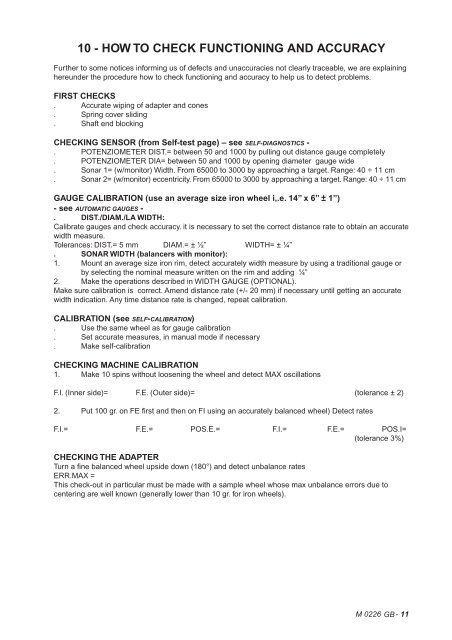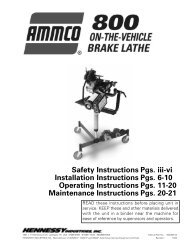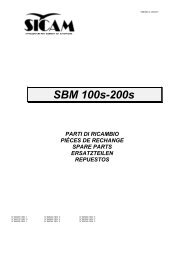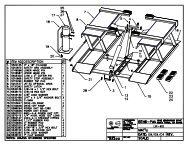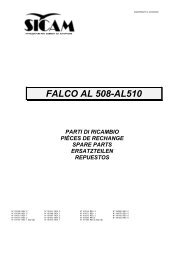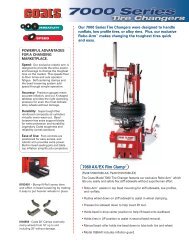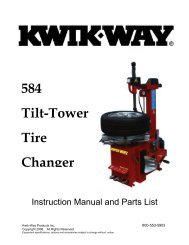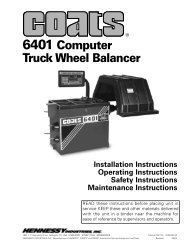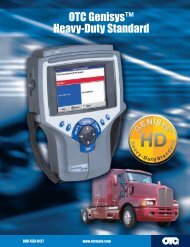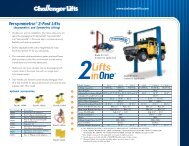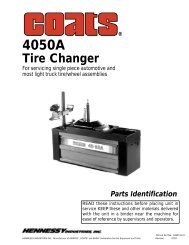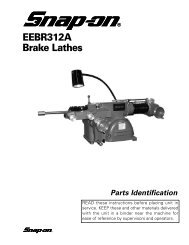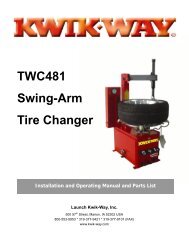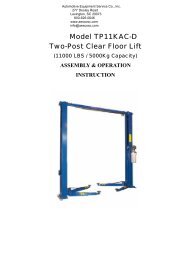CEMB C72 Parts List
CEMB C72 Parts List
CEMB C72 Parts List
Create successful ePaper yourself
Turn your PDF publications into a flip-book with our unique Google optimized e-Paper software.
10 - HOW TO CHECK FUNCTIONING AND ACCURACYFurther to some notices informing us of defects and unaccuracies not clearly traceable, we are explaininghereunder the procedure how to check functioning and accuracy to help us to detect problems.FIRST CHECKS. Accurate wiping of adapter and cones. Spring cover sliding. Shaft end blockingCHECKING SENSOR (from Self-test page) – see SELF-DIAGNOSTICS -. POTENZIOMETER DIST.= between 50 and 1000 by pulling out distance gauge completely. POTENZIOMETER DIA= between 50 and 1000 by opening diameter gauge wide. Sonar 1= (w/monitor) Width. From 65000 to 3000 by approaching a target. Range: 40 ÷ 11 cm. Sonar 2= (w/monitor) eccentricity. From 65000 to 3000 by approaching a target. Range: 40 ÷ 11 cmGAUGE CALIBRATION (use an average size iron wheel i,.e. 14” x 6” ± 1”)- see AUTOMATIC GAUGES -. DIST./DIAM./LA WIDTH:Calibrate gauges and check accuracy. it is necessary to set the correct distance rate to obtain an accuratewidth measure.Tolerances: DIST.= 5 mm DIAM.= ± ½” WIDTH= ± ¼”. SONAR WIDTH (balancers with monitor):1. Mount an average size iron rim, detect accurately width measure by using a traditional gauge orby selecting the nominal measure written on the rim and adding ¼”2. Make the operations described in WIDTH GAUGE (OPTIONAL).Make sure calibration is correct. Amend distance rate (+/- 20 mm) if necessary until getting an accuratewidth indication. Any time distance rate is changed, repeat calibration.CALIBRATION (see SELF-CALIBRATION). Use the same wheel as for gauge calibration. Set accurate measures, in manual mode if necessary. Make self-calibrationCHECKING MACHINE CALIBRATION1. Make 10 spins without loosening the wheel and detect MAX oscillationsF.I. (Inner side)= F.E. (Outer side)= (tolerance ± 2)2. Put 100 gr. on FE fi rst and then on FI using an accurately balanced wheel) Detect ratesF.I.= F.E.= POS.E.= F.I.= F.E.= POS.I=(tolerance 3%)CHECKING THE ADAPTERTurn a fi ne balanced wheel upside down (180°) and detect unbalance ratesERR.MAX =This check-out in particular must be made with a sample wheel whose max unbalance errors due tocentering are well known (generally lower than 10 gr. for iron wheels).M 0226 GB - 11


